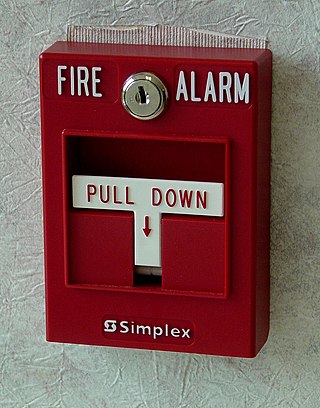History
The company was founded in Waterbury, Connecticut by Charles Warner, the pioneer of the electric clock. The company was later moved to Springfield MA in 1911. Standard quickly became known for its electric clock systems, which were often installed in schools, universities, and other public buildings. These systems consisted of a master clock, which then controlled all secondary clocks. Like many companies during the Great Depression, Standard suffered from financial difficulties throughout the 1930s. In the 1940s during World War II, Standard products were used in many defense projects. In 1950, Standard made a 15,000-square-foot (1,400 m2) addition onto their Springfield plant, and introduced several new product lines, most notably fire alarm systems, fluid analyzer systems, and nurse call systems for use in hospitals. In 1970, it was announced that the company would be sold to Johnson Controls in Milwaukee, Wisconsin. During this period, the company modernized its fire alarm division with the SET/7000, a modular solid-state conventional panel, and later with the SET/7500, a 250-zone multiplex panel in console form that could control fire alarm, security, and building automation systems, along with their light plates and remote lights. In 1978, Johnson Controls sold Standard Electric Time to Faraday. In 1981, Faraday downsized the company substantially, closing all divisions except for standard electric time, and moved it to Tecumseh, Michigan. Faraday is now owned by Siemens, and a small branch office still remains in Springfield.

The UL enterprise is a global safety science company headquartered in Northbrook, Illinois, composed of three organizations, UL Research Institutes, UL Standards & Engagement and UL Solutions.

A smoke detector is a device that senses smoke, typically as an indicator of fire. Smoke detectors/Alarms are usually housed in plastic enclosures, typically shaped like a disk about 150 millimetres (6 in) in diameter and 25 millimetres (1 in) thick, but shape and size vary. Smoke can be detected either optically (photoelectric) or by physical process (ionization). Detectors may use one or both sensing methods. Sensitive alarms can be used to detect and deter smoking in banned areas. Smoke detectors in large commercial and industrial buildings are usually connected to a central fire alarm system.

A bank vault is a secure space where money, valuables, records, and documents are stored. It is intended to protect their contents from theft, unauthorized use, fire, natural disasters, and other threats, much like a safe. Unlike safes, vaults are an integral part of the building within which they are built, using armored walls and a tightly fashioned door closed with a complex lock.

Braun GmbH is a German consumer products company founded in 1921 and based in Kronberg im Taunus. The company is known for its design aesthetic from the 1960s through the 1980s, which included products such as electric shavers, radiograms and record players, movie cameras, slide projectors, clocks, and small kitchen appliances for which "Braun became shorthand for reliable, no-nonsense modernist goods."
Frigidaire Appliance Company is the American consumer and commercial home appliances brand subsidiary of multinational company Electrolux, a Swedish multinational home appliance manufacturer, headquartered in Stockholm.

Johnson Controls International plc is an American, Irish-domiciled multinational conglomerate headquartered in Cork, Ireland, that produces fire, HVAC, and security equipment for buildings. As of mid-2019, it employed 105,000 people in around 2,000 locations across six continents. In 2017 it was listed as 389th in the Fortune Global 500. It became ineligible for the Fortune 500 in subsequent years since it relocated its headquarters outside the U.S.

A fire alarm control panel (FACP), fire alarm control unit (FACU), fire indicator panel (FIP), or simply fire alarm panel is the controlling component of a fire alarm system. The panel receives information from devices designed to detect and report fires, monitors their operational integrity, and provides for automatic control of equipment, and transmission of information necessary to prepare the facility for fire based on a predetermined sequence. The panel may also supply electrical energy to operate any associated initiating device, notification appliance, control, transmitter, or relay. There are four basic types of panels: coded panels, conventional panels, addressable panels, and multiplex systems.

A digital clock displays the time digitally, as opposed to an analogue clock.
SimplexGrinnell, a subsidiary of Johnson Controls, is an American company specializing in active fire protection systems, communication systems and testing, inspection and maintenance services. The company headquarters is in Boca Raton, Florida; corporate sales and marketing offices are in Westminster, Massachusetts, and the company has about 160 district offices throughout North America. It is currently the largest fire protection company in the world.

Manual fire alarm activation is the process of triggering a fire alarm through a call point, pull station, or other device. This usually causes the alarm to sound the evacuation signal for the relevant building or zone. Manual fire alarm activation requires human intervention, as distinct from automatic fire alarm activation such as that provided through the use of heat detectors and smoke detectors. It is, however, possible for call points/pull stations to be used in conjunction with automatic detection as part of the overall fire detection and alarm system. Systems in completed buildings tend to be wired in and include a control panel. Wireless activators are common during construction.

Westclox was an American manufacturer and is a current brand of clocks and alarm clocks. The company's historic plant is located in Peru, Illinois.

A fire alarm system is a building system designed to detect, alert occupants, and alert emergency forces of the presence of fire, smoke, carbon monoxide, or other fire-related emergencies. Fire alarm systems are required in most commercial buildings. They may include smoke detectors, heat detectors, and manual fire alarm activation devices. All components of a fire alarm system are connected to a fire alarm control panel. Fire alarm control panels are usually found in an electrical or panel room. Fire alarm systems generally use visual and audio signalization to warn the occupants of the building. Some fire alarm systems may also disable elevators, which are unsafe to use during a fire under most circumstances.
William Richard Sweatt (1866–1937) was an American industrialist.
An annunciator panel, also known in some aircraft as the Centralized Warning Panel (CWP) or Caution Advisory Panel (CAP), is a group of lights used as a central indicator of status of equipment or systems in an aircraft, industrial process, building or other installation. Usually, the annunciator panel includes a main warning lamp or audible signal to draw the attention of operating personnel to the annunciator panel for abnormal events or condition.

The firm S. H. Couch, often known as simply Couch, was a Quincy, Massachusetts, manufacturing company founded circa 1901 in Boston after the dissolution of Whitman & Couch, a partnership, and a second entity known as Couch & Seeley. S. H. Couch launched during and participated in the turn of the century Independent Telephone Movement which ensued after the expiration of the foundational Bell telephone patents in 1894. The company specialized in electrical devices including telephones, intercoms, and fire alarm systems. S. H. Couch had offices in Boston and in Chicago by 1907.
Faraday is a Florham Park, New Jersey company that specializes in fire protection systems.

Honeywell Gent, formerly Gents' of Leicester, is a British manufacturer of life safety equipment based in Leicester, England. Established by John Thomas Gent, the company is thought to have started in 1872 however it could have been trading as early as the 1860s. The company had a workforce of several hundred at its height.
Autocall is a company that specializes in fire protection and customized communications equipment. The original company was founded in 1908 and was based in Shelby, Ohio. The Autocall brand became defunct in 2001 after it was incorporated into the SimplexGrinnell merger by Tyco International. On September 6, 2016, Johnson Controls and Tyco completed a merger, and Johnson Controls relaunched the Autocall brand in late 2017.
General Electric Specialty Control Plant is a 115 acres (47 ha) historic factory complex located in Waynesboro, Virginia. The complex includes three contributing buildings, one contributing site, and two contributing structures. The historic buildings and structures are a 340,000-square-foot main plant building, the original water tower, water tank, a group of evolved and interconnected construction sheds built from 1953 to the present, and an airplane hangar. The property, a former airport, was acquired by General Electric in 1953. The Waynesboro plant was one of some 120 individual operating departments created as part of a decentralization effort by the General Electric Corporation. The Specialty Control Plant was responsible for the development of breakthrough technologies in areas ranging from America's military efforts to space travel to computer technology. The facility was sold to GENICOM on October 21, 1983.
Umtech Incorporated, also known as VideoBrain Computer Company, was an early entrant in the personal computer market that developed, manufactured, and marketed the first computer, VideoBrain, sold in department stores. Although VideoBrain generated major excitement and strong orders when it was introduced at the January 1978 Consumer Electronics Show (CES), consumers did not adopt it as readily as hoped. The company halted manufacturing in the spring of 1979 and was folded into the structure of its largest financial backer, the Cha Group.












